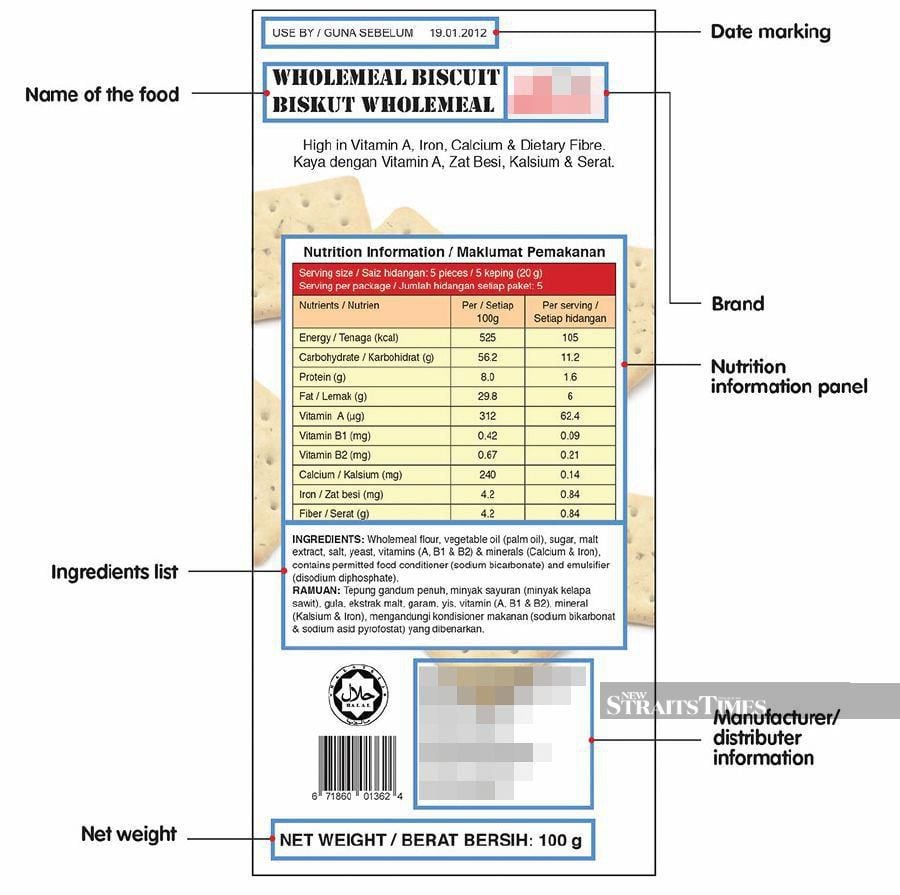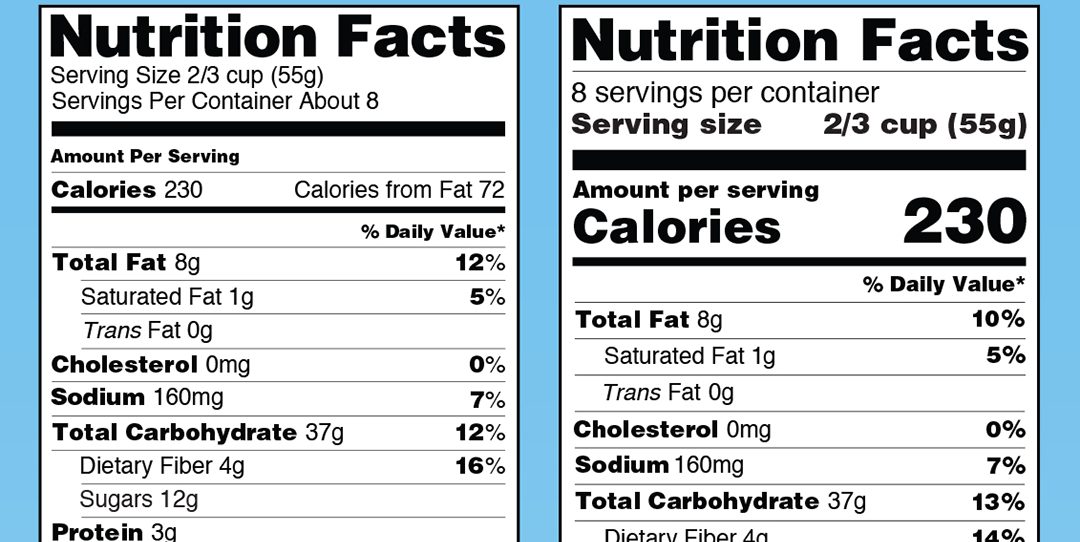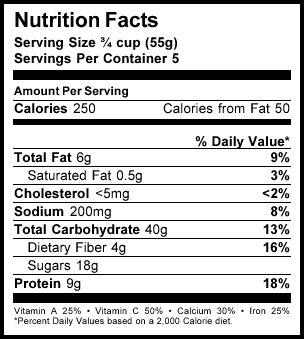42 nutrition labels list the energy content of food in
Energy in Food and Nutrition | Chemistry for Non-Majors | | Course Hero Energy from Protein: 5 g x 4 kcal/g = 20 kcal = 20 Cal. Convert to kJ. 20 Cal x 4.184kJ/Cal = 83.68 kJ = 84 kJ. Step 3: Think about your result . For the snack food in this example, most of the energy is coming from fat first, then from carbohydrates and finally from protein when these three sources of energy are considered. Why Do Food Labels Use Calories Instead of Joules or Kilojoules? The Atwater system is generally used by the food industry for U.S. labels. This is a standard for calculating the energy value of carbohydrates, fats and proteins. These kilocalories are expressed as "calories." The system assigns 4 calories per gram to carbohydrates, 9 calories per gram to fats and 4 calories per gram to proteins.
What are Nutrient Content Claims on food labels ... - Nutritionist Pro™ Nutrient Content Claims on Food Panels List energy, fat, carbohydrates, protein, and sodium. The nutritional information panels are a better guide than advertising. If the product contains food-inducing allergens, the label must say so. Some of the healthiest foods don't have labels, including fresh fruit and vegetables, and fish.

Nutrition labels list the energy content of food in
List of food labeling regulations - Wikipedia Standards of identity for food; Preparation at site of consumption. Shake well; Pricing. Pay what you want (PWYW) Pay what you can (PWYC) Dine and dash; Maximum retail price (MRP) Safety information. Alcohol abuse; Danger zone (food safety) Five-second rule; Food allergy; Food intolerance; Food safety; Food sampling; Food spoilage How to read food labels - healthdirect Sugar: Sugar is a type of carbohydrate. It is better to choose healthier carbohydrates and to limit foods that are high in added sugars. Fibre: High fibre foods such as wholegrain bread and cereals improve digestion and help you to feel full. Sodium: This tells you how much salt the product contains. Eating too much salt is linked to high blood pressure and can lead to heart disease, … How to read food labels - healthdirect information for people with food allergies; a list of food additives; directions for use and storage; the country where the food was produced; Understanding nutrition claims. Some labels tell you what percentage of the recommended daily intake is provided by 1 serve of the product. This helps you to work out how the food fits into a balanced diet.
Nutrition labels list the energy content of food in. How to Understand and Use the Nutrition Facts Label | FDA Feb 25, 2022 · Overview. The information in the main or top section (see #1-4) of the sample nutrition label (below) can vary with each food and beverage product; it contains product-specific information ... Nutrition Labels Flashcards | Quizlet Nutrition Label Required on most packaged food in many countries Calories The amount of energy a food has. Total Fat The total amount of Saturated, unsaturated, and trans in each serving. Serving Size The amount you should eat for one serving. Servings per container The amount of servings in the food item. Percent of Daily Value List of food labeling regulations - Wikipedia Standards of identity for food; Preparation at site of consumption. Shake well; Pricing. Pay what you want (PWYW) Pay what you can (PWYC) Dine and dash; Maximum retail price (MRP) Safety information. Alcohol abuse; Danger zone (food safety) Five-second rule; Food allergy; Food intolerance; Food safety; Food sampling; Food spoilage Nutrition Labels 101: What's Required? What's Optional? Total carbohydrates is a required listing unless there is less than 1 gram, at which point it can be expressed as "contains less than 1 gram," or if less than 0.5 grams per serving, it can be expressed as zero. Sugars are the sneaky nutrient found naturally in many "healthy" foods, including fruit and milk.
Calories on the New Nutrition Facts Label | FDA One package of food may contain more than one serving, so, if you eat two servings you would be getting two times the calories shown on the label. For example, if you ate one serving of the food... A Guide to Reading Food Labels - University of Rochester 27/02/2013 · Food Labels Reading food labels can help you make wise food choices. Most foods list nutrition information on the package label, called Nutrition Facts. These facts can help you compare foods and choose the healthiest option. Sample Label 1 Serving Size Calories . Limit These . Nutrients . Get Enough of These Nutrients 5 Nutrition Facts 18% 15% ... Nutrition labelling | Food Standards Agency energy value must be expressed in kilo joules (kJ) and kilo calories (kcal) and the amount of the nutrients must be expressed in grams (g) all elements must be included next to each other. The... How to Use the Nutrition Facts Label - Diet Doctor 3. Calculate net carbs per serving. Third, check the grams of dietary fiber per serving (circled in green, above). Subtract the fiber (green) from the total carbohydrates (blue) to get the net carbs. This chocolate has 9 grams of net carbs per serving (14g carbs - 5g fiber = 9g net carbs).
Nutrient food labels Flashcards | Quizlet Start studying Nutrient food labels. Learn vocabulary, terms, and more with flashcards, games, and other study tools. Home Browse. ... •Total food energy; food energy from fat •Total fat; saturated fat; trans fat; cholesterol ... Nutrition 2.1 Food Labels. 42 terms. Diana_Lopez0920. health claims and food labels. 50 terms. sydneyfinder. Energy (kJ) Content of Foods - Whole Food Catalog You can find out about Energy (kJ) Content of Foods. In this website, nutritional content included in 1878 kinds of foods are introduced by using graphs etc. Energy (kJ) Content of Foods. 472 kj (per 12 g edible portion) Lard. 393 kj (per 10 g edible portion) Beef tallow. 462 kj (per 12 g edible portion) Shortening. Food energy - Wikipedia Many governments require food manufacturers to label the energy content of their products, to help consumers control their energy intake. To facilitate evaluation by consumers, food energy values (and other nutritional properties) in package labels or tables are often quoted for convenient amounts of the food, rather than per gram or kilogram; such as in "calories per serving" or "kcal per 100 ... Nutritional Values For Common Foods And Products Highest caloric density foods Top Foods by Vitamin Vitamin A Thiamin Riboflavin Niacin Pantothenic acid Vitamin B6 Vitamin B12 Folate Vitamin C Vitamin D Vitamin E Vitamin K1 Betaine Choline Top Foods by Mineral Calcium, Ca Copper, Cu Fluoride, F Iron, Fe Magnesium, Mg Manganese, Mn Phosphorus, P Potassium, K Selenium, Se Sodium, Na Zinc, Zn
Food labels: a guide to reading nutrition labels - MyDr.com.au A food making a 'diet' claim must meet some criteria regarding the content of nutrients of public health significance (saturated fat, sugars and sodium) and must either have no more than 80 kJ/100 mL (for liquid foods) or 160 kJ/100 g (for solid foods) or must have at least 40% fewer kilojoules than the same quantity of a reference food.
Food Labels (for Teens) - Nemours KidsHealth Food labels provide more than just nutrition facts. They also tell you what's in a packaged food (i.e., the ingredients). People with food allergies need to check ingredient lists to avoid foods that can cause an allergic reaction. Some food labels also state which country the food came from, whether the food is organic, and certain health claims.
Food energy - Wikipedia Many governments require food manufacturers to label the energy content of their products, to help consumers control their energy intake. To facilitate evaluation by consumers, food energy values (and other nutritional properties) in package labels or tables are often quoted for convenient amounts of the food, rather than per gram or kilogram; such as in "calories per …
Nutrition information panels - Food Standards Protein, fat, carbohydrate, dietary fibre and alcohol all provide energy (kilojoules). Protein Protein is essential for good health and is particularly important for children. Generally, people in developed countries eat enough protein to meet their requirements. Meat, poultry, fish, eggs, milk and cheese are animal sources of protein.
Federal Register :: Food Labeling: Revision of the Nutrition ... May 27, 2016 · The comment also stated that the 2012 IOM report on front-of-pack labeling (Ref. 2) found that “a lack of nutrition knowledge is a major barrier to effective use of the [Nutrition Facts label] and may actually lower the motivation of some consumers to use the nutrition information on the label,” and that “some racial groups . . . are less ...
How to Calculate Energy From Foods - LIVESTRONG.COM Step 1 Multiply grams of carbohydrate in the food by 4 calories per gram. A calorie is a unit of how much energy is in a given amount of food, also called a kcal. Regardless of whether the carbohydrate in food is sugar or starch, all carbohydrates provide the body with 4 calories/gram, explains Dr. Lauralee Sherwood in her book "Human Physiology."
human nutrition | Importance, Essential Nutrients, Food Groups, … human nutrition, process by which substances in food are transformed into body tissues and provide energy for the full range of physical and mental activities that make up human life. The study of human nutrition is interdisciplinary in character, involving not only physiology, biochemistry, and molecular biology but also fields such as psychology and anthropology, …
Food Labels: Carbohydrates | Home & Garden Information Center According to nutrition experts, carbohydrates should provide 45-65% of your total daily calories. That means carbohydrates should supply 900 calories or more in a 2,000-calorie-a-day diet. Facts on Food Labels. Food labels contain clues to a food's carbohydrate content, including the amount per serving.





Post a Comment for "42 nutrition labels list the energy content of food in"